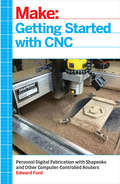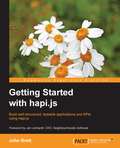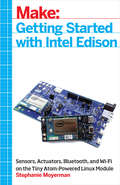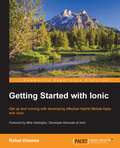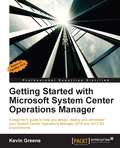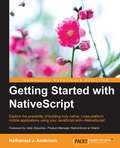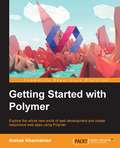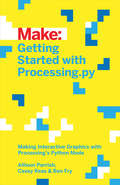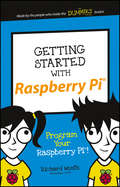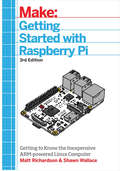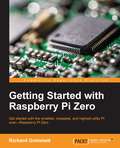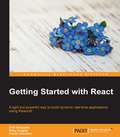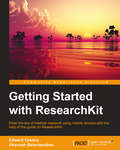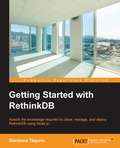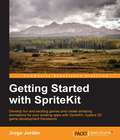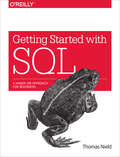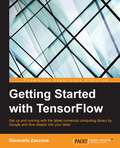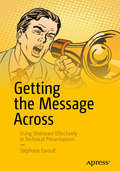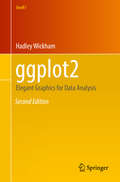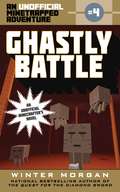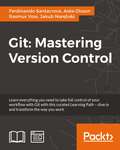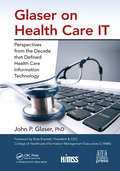- Table View
- List View
Getting Started with CNC: Personal Digital Fabrication with Shapeoko and Other Computer-Controlled Routers
by Edward FordGetting Started with CNC is the definitive introduction to working with affordable desktop and benchtop CNCs, written by the creator of the popular open hardware CNC, the Shapeoko. Accessible 3D printing introduced the masses to computer-controlled additive fabrication. But the flip side of that is subtractive fabrication: instead of adding material to create a shape like a 3D printer does, a CNC starts with a solid piece of material and takes away from it. Although inexpensive 3D printers can make great things with plastic, a CNC can carve highly durable pieces out of a block of aluminum, wood, and other materials. This book covers the fundamentals of designing for--and working with--affordable ($500-$3000) CNCs.
Getting Started with hapi.js
by John BrettBuild well-structured, testable applications and APIs using hapi.js About This Book * With the help of this book, you will improve your productivity as a developer and that of your team by focusing on business logic utilizing the structure that Hapi.js provides * You will be introduced to a real-world problem and we'll demonstrate how to use the tools Hapi provides to resolve it * This is the only book with a learn-by-example approach Who This Book Is For If you are a JavaScript developer with or without Node.js experience and would like to learn to build applications, APIs, and web servers with the best-in-class framework hapi.js, this book is perfect for you. What You Will Learn * Increase your productivity by taking advantage of the out-of-the-box features hapi.js provides * Build secure API servers * Create websites and applications using your favorite templating language * Leverage hapi.js plugins to better structure your codebase * Simplify your security workflows with the built-in authentication and authorization functionality of hapi.js * Ensure application reliability with testing and code coverage * Reduce code complexity using reusable validation logic with joi * Gather insight into your application performance via logging * Start the journey to building robust production-ready applications In Detail This book will introduce hapi.js and walk you through the creation of your first working application using the out-of-the-box features hapi.js provides. Packed with real-world problems and examples, this book introduces some of the basic concepts of hapi.js and Node.js and takes you through the typical journey you'll face when developing an application. Starting with easier concepts such as routing requests, building APIs serving JSON, using templates to build websites and applications, and connecting databases, we then move on to more complex problems such as authentication, model validation, caching, and techniques for structuring your codebase to scale gracefully. You will also develop skills to ensure your application's reliability through testing, code coverage, and logging. By the end of this book, you'll be equipped with all the skills you need to build your first fully featured application. This book will be invaluable if you are investigating Node.js frameworks or planning on using hapi.js in your next project. Style and approach This book takes a step-by-step approach to building an application or web server using hapi.js though examples.
Getting Started with Intel Edison
by Stephanie MoyermanThe Intel Edison is a crowning achievement of Intel's adaptation of its technology into maker-friendly products. They've packed the dual-core power of the Atom CPU, combined it with a sideboard microcontroller brain, and added in Wi-Fi, Bluetooth Low Energy, and a generous amount of RAM (1GB) and flash storage (4GB). This book, written by Stephanie Moyerman, a research scientist with Intel's Smart Device Innovation Team, teaches you everything you need to know to get started making things with Edison, the compact and powerful Internet of Things platform. Projects and tutorials include: Controlling devices over BluetoothUsing Python and Arduino programming environments on EdisonTracking objects with a webcam and OpenCVResponding to voice commands and talking backUsing and configuring Linux on Edison
Getting Started with Ionic
by Rahat KhannaGet up and running with developing effective Hybrid Mobile Apps with IonicAbout This BookDevelop engaging mobile experiences with a native-looking UI in Ionic and AngularJSBuild mobile applications with a native UI and interactions with device APIs using popular web technologies such as HTML, CSS, and JavaScriptCreate an e-commerce mobile app using tutorials and code samplesWho This Book Is ForThis book is ideal for any web developer who wants to enter into the world of mobile app development but has no clue where to start. Ionic is an ideal starting point and provides a smooth learning curve to help you build hybrid apps using web technologies and to develop native apps for iOS and Android, you do not need to know multiple languages. This book will also be useful for Hybrid App developers who have not found the perfect framework to ensure users get a rich experience from your apps.What You Will LearnGet to know about Hybrid Apps and AngularJSSet up a development environment to build Hybrid AppsNavigate around the components and routing in IonicUse different Ionic directives for a mobile-specific experienceIntegrate an Ionic App with backend web servicesWork with plugins to include native functionality in your hybrid appsTest your apps on real devicesBuild an e-commerce app for iOS and Android from scratchIn DetailHybrid Apps are a promising choice in mobile app development to achieve cost effectiveness and rapid development. However, they were not preferred over native apps until few years back due to a poor performance and bad user experience, but everything has changed with the release of Ionic. It has evolved as the most popular choice for Hybrid Mobile App development as it tends to match the native experience and provides robust components/tools to build apps.Getting Started with Ionic equips any web developer with the basic knowledge needed to use modern web technologies to build amazing hybrid mobile apps using Ionic.This fast-paced, practical book explains all the important concepts of AngularJS and Cordova Framework required to develop apps, then gives you a brief introduction to hybrid mobile applications. It will guide you through setting up the environment to develop mobile apps, and through the multiple options and features available in Ionic so you can use them in your mobile apps. Features such as the Side Menu, Tabs, Touch Interactions, and native features such as Bar Code, Camera, and Geolocations are all covered.. Finally, we'll show you how to use Cordova plugins and publish your apps.Style and approachGetting started with Ionic is a compact, easy-to-follow guide to developing hybrid mobile apps using Ionic with real world examples of building an e-commerce app.
Getting Started with Microsoft System Center Operations Manager
by Kevin GreeneThe target audience for the book is the IT Pro or System Administrator who wants to deploy and use System Center Operations Manager but has no previous knowledge of the product.
Getting Started with NativeScript
by Nathanael J. AndersonExplore the possibility of building truly native, cross-platform mobile applications using your JavaScript skill--NativeScript! About This Book * Save your marketing time by building for iOS, Android, and Windows Mobile platforms simultaneously * Be an ace at utilizing the features of NativeScript and its ability to communicate with each of the host device libraries natively * Proficiently, build your fully cross-platform communication application exhibiting the fundamentals of NativeScript Who This Book Is For If you are a JavaScript developer and want to build cross-platform applications, then this book is just the right one for you! What You Will Learn * Install and compile your application in NativeScript * Get important know-how on the NativeScript project structure * Develop and style your screens for multiple platforms * Create a full-featured cross-platform communication application * Import and use several third-party components * Simplify and deal with device resolution and cross-platform issues * Test and deploy your application In Detail NativeScript allows you to build a fast cross-platform application that has a native UI. NativeScript is a true cross-platform framework that generates native speed applications using the native components of the host platform, all using JavaScript. Although NativeScript allows you to build your application in JavaScript, you have full access to the host OS from your code, allowing you to easily tweak or use new platform features instantly at native code speeds. Whether you have already developed multiple applications or zero applications, this book will help you to develop your next application in a cross-platform framework quickly, saving you a massive amount of time and money. This book concisely shows you NativeScript's built-in framework that allows you to rapidly develop a fully-working compiled cross-platform application in just a few chapters. It starts by laying the foundation of NativeScript and working through the fundamentals to create a basic shell of the application. Moving on, you'll see how to build a full-fledged application step by step. We'll show you how to use plugins, and how to communicate with the native OS libraries easily so that you can customize your application as if your app was created in Java or Objective C. We then deal with the issues that arise from being cross platform and compensate for the different screen sizes, screen resolutions, and device abilities. Finally, we progress to testing and deploying your app. Style and approach A stepwise guide for building cross-platform mobile applications with the help of easy-to-understand examples.
Getting Started with Polymer
by Arshak KhachatrianExplore the whole new world of web development and create responsive web apps using Polymer About This Book * Get to grips with the principles of Material Design and Google Web components * Make full use of the Polymer Designer Tool, Polymer Starter Kit, and Dart to create responsive web apps * An in-depth guide with real-life examples so you can learn everything you need to know about Polymer Who This Book Is For If you are a beginner-level web developer who would like to learn the concepts of web development using the Polymer library, then this is the book for you. Knowledge of JavaScript and HTML is expected. What You Will Learn * Understand the basics of web components such as Shadow DOM, HTML imports, Templates, and custom elements * Familiarize yourself with the principles of Material Design * Install Polymer on your system and create your project structure * Use the different Polymer 1.0 elements in your code * Work with Polymer.dart and create your own app * Get to know the best practices in Polymer programming from the top guys in the Polymer team In Detail Polymer is a library that helps you develop fast, responsive applications for the desktop and mobile web. It uses the Web Components specifications for the components and Material Design concepts to create a beautiful user interface. This focused, fast-paced guide deals with Polymer web components. We will cover layouts, attributes, elements, and handling touch and gesture events. You will also see how to build custom web components and applications using Polymer. Don't want to code? You can make the most of the Polymer Designer Tool app and create your own app without coding at all. Finally, you will see how you can improve your Polymer application by reading the best practices from Google Polymer team. By the end of this book, you will be equipped with all the necessary skills to use Polymer to create custom web components. Style and approach This is your guide to designing custom web components, and the concepts are explained in a conversational and easy-to-follow style. Each topic is explained through examples, with detailed explanations wherever required.
Getting Started with Processing.py: Making Interactive Graphics with Python's Processing Mode
by Casey Reas Ben Fry Allison ParrishProcessing opened up the world of programming to artists, designers, educators, and beginners. The Processing.py Python implementation of Processing reinterprets it for today's web. This short book gently introduces the core concepts of computer programming and working with Processing. Written by the co-founders of the Processing project, Reas and Fry, along with co-author Allison Parrish, Getting Started with Processing.py is your fast track to using Python's Processing mode.
Getting Started with Raspberry Pi
by Richard WentkA technology book for kids! Do you want to learn how computers work? This book introduces you to the world of computing with the Raspberry Pi - the small, inexpensive, and super-cool microcomputer that teaches real tech skills. Use the Pi to create things while learning all about computers, from the inside out! Start it up --get your Raspberry Pi set up, configured, and ready for action Create music --start the party using Sonic Pi to record your own songs Game on --combine Python® and Minecraft® and start programming your own video game world.
Getting Started With Raspberry Pi: An Introduction to the Fastest-Selling Computer in the World
by Shawn Wallace Matt RichardsonThe Raspberry Pi is a credit card-sized computer that plugs into your TV and a keyboard. It is a capable little computer which can be used in electronics projects, and for many of the things that your desktop PC does, like spreadsheets, word processing, browsing the internet, and playing games. It also plays high-definition video. This book takes you step-by-step through many fun and educational possibilities. Take advantage of several preloaded programming languages. Use the Raspberry Pi with Arduino. Create Internet-connected projects. Play with multimedia. With Raspberry Pi, you can do all of this and more.
Getting Started with Raspberry Pi Zero
by Richard GrimmettGet started with the smallest, cheapest, and highest-utility Pi ever--Raspberry Pi Zero About This Book * Get started with Raspberry Pi Zero and put all of its exciting features to use * Create fun games and programs with little or no programming experience * Learn to use this super-tiny PC to control hardware and software for work, play, and everything else Who This Book Is For This book is for hobbyists and programmers who are taking their first steps toward using Raspberry Pi Zero. No programming experience is required, although some Python programming experience might be useful. What You Will Learn * Understand how to initially download the operating system and set up Raspberry Pi Zero * Find out how to control the GPIO pins of Raspberry Pi Zero to control LED circuits * Get to grips with adding hardware to the GPIO to control more complex hardware such as motors * Add USB control hardware to control a complex robot with 12 servos * Include speech recognition so that projects can receive commands * Enable the robot to communicate with the world around it by adding speech output * Control the robot from a distance and see what the robot is seeing by adding wireless communication * Discover how to build a Robotic hand and a Quadcopter In Detail Raspberry Pi Zero is half the size of Raspberry Pi A, only with twice the utility. At just three centimeters wide, it packs in every utility required for full-fledged computing tasks. This practical tutorial will help you quickly get up and running with Raspberry Pi Zero to control hardware and software and write simple programs and games. You will learn to build creative programs and exciting games with little or no programming experience. We cover all the features of Raspberry Pi Zero as you discover how to configure software and hardware, and control external devices. You will find out how to navigate your way in Raspbian, write simple Python scripts, and create simple DIY programs. Style and approach This is a practical and fun ?getting started? tutorial that will guide you through everything new that the Raspberry Pi has to offer.
Getting Started with React
by Manu Singhal Doel Sengupta Danillo CorvalanA light but powerful way to build dynamic real-time applications using ReactJS About This Book * Learn how to develop powerful JavaScript applications using ReactJS * Integrate a React-based app with an external API (Facebook login) while using React components, with the Facebook developer app * Implement the Reactive paradigm to build stateless and asynchronous apps with React Who This Book Is For This book is for any front-end web or mobile-app developer who wants to learn ReactJS. Knowledge of basic JavaScript will give you a good head start with the book. What You Will Learn * Understand the ReactJS basics through an overview * Install and create your first React component * Refactor the ReactJS component using JSX * Integrate your React application with the Facebook login and Graph API, then fetch data from your liked pages in Facebook and display them in a browser * Handle UI elements events with React, respond to users input, and create stateful components * Use some core lifecycle events for integration and find out about ES6 syntaxes in the React world * Understand the FLUX architecture and create an application using FLUX with React * Make a component more reusable with mixins and validation helpers and structure your components properly * Explore techniques to test your ReactJS code * Deploy your code using webpack and Gulp In Detail ReactJS, popularly known as the V (view) of the MVC architecture, was developed by the Facebook and Instagram developers. It follows a unidirectional data flow, virtual DOM, and DOM difference that are generously leveraged in order to increase the performance of the UI. Getting Started with React will help you implement the Reactive paradigm to build stateless and asynchronous apps with React. We will begin with an overview of ReactJS and its evolution over the years, followed by building a simple React component. We will then build the same react component with JSX syntax to demystify its usage. You will see how to configure the Facebook Graph API, get your likes list, and render it using React. Following this, we will break the UI into components and you'll learn how to establish communication between them and respond to users input/events in order to have the UI reflect their state. You'll also get to grips with the ES6 syntaxes. Moving ahead, we will delve into the FLUX and its architecture, which is used to build client-side web applications and complements React's composable view components by utilizing a unidirectional data flow. Towards the end, you'll find out how to make your components reusable, and test and deploy them into a production environment. Finally, we'll briefly touch on other topics such as React on the server side, Redux and some advanced concepts. Style and approach The book follows a step-by-step, practical, tutorial approach with examples that explain the key concepts of ReactJS. Each topic is sequentially explained and contextually placed to give sufficient details of ReactJS.
Getting Started with ResearchKit
by Edward Cessna Dhanush BalachandranEnter the era of medical research using mobile devices with the help of this guide on ResearchKit! About This Book * Create a simple clinical research app using most aspects of ResearchKit * Build a simple survey with various data types with the results printed on the screen. * A step-by-step guide introducing Apple's ResearchKit and techniques to incorporate it into various apps. Who This Book Is For This book is aimed at medical researchers with basic iOS coding knowledge and iOS developers looking to create clinical research apps. What You Will Learn * Learn to create customized consent form * Get introduced to two backend services: a simple backend server using Sinatra and Sage Bridge * Build a custom task (a conditional survey example) and a navigable task * Get an Overview of ResearchKit's open source repository and App Core * Interaction with the hardware of the device including the gyro and the motion sensors * Learn the basics of this revolutionary technology * Get introduced to the barebones app and learn to write your first code In Detail ResearchKit is an open source software development framework from Apple that lets you easily create mobile applications for clinical research studies. ResearchKit provides you the ability to orchestrate the administration of tasks and recording of the results. ResearchKit provides tasks in order to perform informed consent, active tasks, and surveys. Starting with the basics of the ResearchKit framework, this books walks you through the steps of creating iOS applications that could serve as the basis of a clinical research mobile app. This book will introduce readers to ResearchKit and how to turn your iPhone into into a clinical research tool. The book will start off by installing and building the research framework in line with the researcher's needs; during this, the reader will learn to embed ResearchKit in the application and create a small task. After this, the book will go a little deeper into creating modules for surveys, consents, and so on. The book will also cover the various aspects of privacy and security with regard to participant data, and how to build dashboards for visualizing medical data and results in line with the researcher's requirements: data backends, JSON serialization and deserialization, and so on. Readers will be able to fully utilize ResearchKit for medical research, will be able to get more and more patients to participate in their surveys, and will gain insights from the surveys using the dashboards created. Style and approach A hands-on guide with ample screenshots for you to follow and learn about ResearchKit. Each topic is explained sequentially and placed in context so that you can get a better understanding of every step in the process of creating clinical research apps.
Getting Started with RethinkDB
by Gianluca TiepoloAbsorb the knowledge required to utilize, manage, and deploy RethinkDB using Node.js About This Book * Make the most of this open source, scalable database--RethinkDB --to ease the construction of web applications * Run powerful queries using ReQL, which is the most convenient language to manipulate JSON documents with * Develop fully-fledged real-time web apps using Node.js and RethinkDB Who This Book Is For Getting Started with RethinkDB is ideal for developers who are new to RethinkDB and need a practical understanding to start working with it. No previous knowledge of database programming is required, although a basic knowledge of JavaScript or Node.js would be helpful. What You Will Learn * Download and install the database on your system * Configure RethinkDB's settings and start using the web interface * Import data into RethinkDB * Run queries using the ReQL language * Create shards, replicas, and RethinkDB clusters * Use an index to improve database performance * Get to know all the RethinkDB deployment techniques In Detail RethinkDB is a high-performance document-oriented database with a unique set of features. This increasingly popular NoSQL database is used to develop real-time web applications and, together with Node.js, it can be used to easily deploy them to the cloud with very little difficulty. Getting Started with RethinkDB is designed to get you working with RethinkDB as quickly as possible. Starting with the installation and configuration process, you will learn how to start importing data into the database and run simple queries using the intuitive ReQL query language. After successfully running a few simple queries, you will be introduced to other topics such as clustering and sharding. You will get to know how to set up a cluster of RethinkDB nodes and spread database load across multiple machines. We will then move on to advanced queries and optimization techniques. You will discover how to work with RethinkDB from a Node.js environment and find out all about deployment techniques. Finally, we'll finish by working on a fully-fledged example that uses the Node.js framework and advanced features such as Changefeeds to develop a real-time web application. Style and approach This is a step-by-step book that provides a practical approach to RethinkDB programming, and is explained in a conversational, easy-to-follow style.
Getting Started with SpriteKit
by Jorge JordanDevelop fun and exciting games and create amazing animations for your existing apps with SpriteKit, Apple's 2D game development framework About This Book * Learn the key concepts of game development in iOS * Take advantage of SpriteKit to create your own games and improve your apps * Follow the step-by-step chapters to create a complete product ready to submit to the App Store Who This Book Is For Getting Started with SpriteKit is for beginner-level iOS developers who want to add an extra edge to their apps and create amazing games using SpriteKit. It doesn't matter whether you have experience in iOS development or not as this book will show you the swift tricks you can use to create games. What You Will Learn * Create and configure a SpriteKit project from scratch * Load and manage the basic elements of games such as sprites, labels, and geometrical primitives * Handle touch events, detect collisions, and play sound audio files * Create complex elements, animate sprites, and run the parallax effect * Complete your games with key components such as a main menu, transitions between scenes, a tutorial, and the ability to load and save data * Increase the efficiency of your device using the accelerometer or by adding shaders, lights, and shadows * Gain complementary techniques such as creating or finding audio resources, applying SpriteKit to apps, or using third-party tools In Detail SpriteKit is Apple's game engine to develop native iOS games. Strongly boosted by the Apple Inc., Cupertino, it has increased in popularity since its first release. This book shows you the solutions provided by SpriteKit to help you create any 2D game you can imagine and apply them to create animations that will highlight your existing apps. This book will give you the knowledge you need to apply SpriteKit to your existing apps or create your own games from scratch. Throughout the book, you will develop a complete game. The beautiful designs implemented in the game in this book will easily lead you to learn the basis of 2D game development, including creating and moving sprites, and adding them to a game scene. You will also discover how to apply advanced techniques such as collision detection, action execution, playing music, or running animations to give a more professional aspect to the game. You will finish your first game by learning how to add a main menu and a tutorial, as well as saving and loading data from and to the player's device. Finally, you will find out how to apply some mobile games techniques such as accelerometer use or touch detection. Style and approach Written in an informal way with plenty of illustrative screenshots, this easy-to-follow and practical guide will help you get the most from SpriteKit. The main part of the book provides step-by-step instructions to develop of a complete product, while the last chapters give you some complementary techniques than can be used in mobile 2D game development.
Getting Started with SQL: A Hands-on Approach For Beginners
by Thomas NieldBusinesses are gathering data today at exponential rates and yet few people know how to access it meaningfully. If you're a business or IT professional, this short hands-on guide teaches you how to pull and transform data with SQL in significant ways. You will quickly master the fundamentals of SQL and learn how to create your own databases.Author Thomas Nield provides exercises throughout the book to help you practice your newfound SQL skills at home, without having to use a database server environment. Not only will you learn how to use key SQL statements to find and manipulate your data, but you'll also discover how to efficiently design and manage databases to meet your needs.You'll also learn how to:Explore relational databases, including lightweight and centralized modelsUse SQLite and SQLiteStudio to create lightweight databases in minutesQuery and transform data in meaningful ways by using SELECT, WHERE, GROUP BY, and ORDER BYJoin tables to get a more complete view of your business dataBuild your own tables and centralized databases by using normalized design principlesManage data by learning how to INSERT, DELETE, and UPDATE records
Getting Started with TensorFlow
by Giancarlo ZacconeGet up and running with the latest numerical computing library by Google and dive deeper into your data! About This Book * Get the first book on the market that shows you the key aspects TensorFlow, how it works, and how to use it for the second generation of machine learning * Want to perform faster and more accurate computations in the field of data science? This book will acquaint you with an all-new refreshing library--TensorFlow! * Dive into the next generation of numerical computing and get the most out of your data with this quick guide Who This Book Is For This book is dedicated to all the machine learning and deep learning enthusiasts, data scientists, researchers, and even students who want to perform more accurate, fast machine learning operations with TensorFlow. Those with basic knowledge of programming (Python and C/C++) and math concepts who want to be introduced to the topics of machine learning will find this book useful. What You Will Learn * Install and adopt TensorFlow in your Python environment to solve mathematical problems * Get to know the basic machine and deep learning concepts * Train and test neural networks to fit your data model * Make predictions using regression algorithms * Analyze your data with a clustering procedure * Develop algorithms for clustering and data classification * Use GPU computing to analyze big data In Detail Google's TensorFlow engine, after much fanfare, has evolved in to a robust, user-friendly, and customizable, application-grade software library of machine learning (ML) code for numerical computation and neural networks. This book takes you through the practical software implementation of various machine learning techniques with TensorFlow. In the first few chapters, you'll gain familiarity with the framework and perform the mathematical operations required for data analysis. As you progress further, you'll learn to implement various machine learning techniques such as classification, clustering, neural networks, and deep learning through practical examples. By the end of this book, you'll have gained hands-on experience of using TensorFlow and building classification, image recognition systems, language processing, and information retrieving systems for your application. Style and approach Get quickly up and running with TensorFlow using this fast-paced guide. You will get to know everything that can be done with TensorFlow and we'll show you how to implement it in your environment. The examples in the book are from the core of the computation industry--something you can connect to and will find familiar.
Getting the Message Across
by Stéphane FaroultCreate memorable presentations on technical and complex topics in slideware such as Microsoft PowerPoint and Apple’s Keynote for Mac. Learn good pacing and rhythm as well as judicious use of special effects.Whether the goal is to help a sale or to educate, and whether the final delivery is a live presentation, a webinar, or a short video presentation, this book focuses on the particular difficulties linked to technical presentations. You will learn to create a story when there is none, gain the interest of an audience who may not feel as strongly for the topic as the speaker does, turn abstract concepts into visual models, overcome the limitations of the medium (limited space, two dimensions), maintain interest through rhythm, and use effects, not to look cool or get that "WOW" moment, but to serve the message.Getting The Message Across presents a number of field-tested ideas for raising interest. The use of various techniques and careful scripting will help you, even if you aren't a natural-born show-person, to communicate effectively, and to make your audience remember your message, and not necessarily your slides. This book will teach you:Rhythm and animations, and the use of transitionsTo hold audience interest even with "dry" topicsTo create memorable presentationsTechniques useful for PowerPoint, Keynote for Mac, and any similar presentation medium or environmentWhat You Will LearnTurn austere topics into interesting stories.Give rhythm and pacing to your presentations.Build a narrative during transitions and animations.Hold audience interest and make listeners feel clever.Make people remember your presentation rather than your cool use of slideware.Who This Book Is ForPeople who have to communicate effectively on strongly technical topics. This book targets educators and trainers as well as technical consultants who need to present complex solutions to customers or leads, as well as would-be speakers at scientific or technical conferences. Getting The Message Across is a book for people who want to make their presentations not only more attractive, but really memorable. It is for people who aren't looking for a standing ovation, but who are willing to do what they can to be understood and to make their messages remembered. Getting The Message Across focuses on using slideware such as PowerPoint and Keynote. Such slideware, for all its flaws, is still one of the best ways to communicate, not only live, but also in dematerialized communications (webinars, video tutorials) for reaching an ever-growing audience.
Getting to Yes with China in Cyberspace
by Astrid Stuth Cevallos Scott Warren Harold Martin C. LibickiThis study explores U.S. policy options for managing cyberspace relations with China via agreements and norms of behavior. It considers two questions: Can negotiations lead to meaningful agreement on norms? If so, what does each side need to be prepared to exchange in order to achieve an acceptable outcome? This analysis should interest those concerned with U.S.-China relations and with developing norms of conduct in cyberspace.
ggplot2
by Hadley WickhamThis new edition to the classic book by ggplot2 creator Hadley Wickham highlights compatibility with knitr and RStudio. ggplot2 is a data visualization package for R that helps users create data graphics, including those that are multi-layered, with ease. With ggplot2, it's easy to: produce handsome, publication-quality plots with automatic legends created from the plot specification superimpose multiple layers (points, lines, maps, tiles, box plots) from different data sources with automatically adjusted common scales add customizable smoothers that use powerful modeling capabilities of R, such as loess, linear models, generalized additive models, and robust regression save any ggplot2 plot (or part thereof) for later modification or reuse create custom themes that capture in-house or journal style requirements and that can easily be applied to multiple plots approach a graph from a visual perspective, thinking about how each component of the data is represented on the final plot This book will be useful to everyone who has struggled with displaying data in an informative and attractive way. Some basic knowledge of R is necessary (e. g. , importing data into R). ggplot2 is a mini-language specifically tailored for producing graphics, and you'll learn everything you need in the book. After reading this book you'll be able to produce graphics customized precisely for your problems, and you'll find it easy to get graphics out of your head and on to the screen or page.
Ghastly Battle (The Unofficial Minetrapped Adventure #4)
by Winter MorganPeace has been restored to the Overworld after an epic griefer battle. Lily, Simon, and Michael are glad to have a break from fighting, and even from their attempts to escape the game and return to their normal lives. <p><p> But then two new players are zapped onto the server, and no one’s sure who’s responsible for trapping them. With Mr. Anarchy and the other griefers in prison, anyone could be a suspect, and tempers flare as the townspeople’s suspicions turn inward. While Lily, Simon, and Michael are away seeking clues, the people of Lisimi Village turn against them, convinced that they’re keeping the knowledge of how to return home to themselves. Can the trio convince their friends of their innocence, bring the real villains to justice, and finally make their way home? <p> Friendships are tested and unlikely allies emerge in this thrilling fourth book in bestselling author Winter Morgan’s Unofficial Minetrapped Adventure series.
Girls' Feminist Blogging in a Postfeminist Age (Routledge Studies in New Media and Cyberculture)
by Jessalynn KellerGirls’ Feminist Blogging in a Postfeminist Age explores the practices of U.S.-based teenage girls who actively maintain feminist blogs and participate in the feminist blogosphere as readers, writers, and commenters on platforms including Blogspot, Facebook, Twitter, and Tumblr. Drawing on interviews with bloggers between the ages of fifteen and twenty-one, as well as discursive textual analyses of feminist blogs and social networking postings authored by teenage girls, Keller addresses how these girls use blogging as a practice to articulate contemporary feminisms and craft their own identities as feminists and activists. In this sense, feminist girl bloggers defy hegemonic postfeminist and neoliberal girlhood subjectivities, a finding that Keller uses to complicate both academic and popular assertions that suggest teenage girls are uninterested in feminism. Instead, Keller maintains that these young bloggers employ digital media production to educate their peers about feminism, connect with like-minded activists, write feminist history, and make feminism visible within popular culture, practices that build upon and continue a lengthy tradition of American feminism into the twenty-first century. Girls’ Feminist Bloggers in a Postfeminist Age challenges readers to not only reconsider teenage girls’ online practices as politically and culturally significant, but to better understand their crucial role in a thriving contemporary feminism.
Git: Mastering Version Control
by Rasmus Voss Jakub Narebski Ferdinando Santacroce Aske OlssonLearn everything you need to take full control of your workflow with Git with this curated Learning Path - dive in and transform the way you work About This Book * Master all the basic concepts of Git to protect your code and make it easier to evolve * Filled with practical recipes that will teach you how to use the most advanced features of the Git system * Harness the full power of the Git version control system to customize Git behavior, manipulate history, integrate external tools, and explore platform shortcuts Who This Book Is For This learning path is for software developers who want to become proficient at using the Git version control system. A basic understanding of any version control system would be beneficial. What You Will Learn * Transport your work to a remote repository in a centralized manner * Experiment with your code without affecting functional code files * Explore some tools used to migrate to Git from other versioning systems without losing your development history * Understand the Git data model and how you can navigate the database with simple commands * Debug with Git and use various techniques to find faulty commits * Customize Git behavior system-wide, on a per-user, per-repository, and per-file basis * Master administering and setting up Git repositories, configuring access, finding and recovering from repository errors, and performing repository maintenance * Chose a workflow and configure/set up support for the chosen workflow In Detail Git is one of the most popular types of Distributed Version Control System. Since its inception, it has attracted skilled developers due to its robust, powerful, and reliable features. Like most powerful tools, Git can be hard to approach for the newcomers. However, this learning path will help you overcome this fear and become adept at all the basic and advanced tasks in Git. This course starts with an introduction to version control systems before you delve deeply into the essentials of Git. This serves as a primer for the topics to follow such as branching and merging, creating and managing a GitHub personal repository, and fork and pull requests. You'll also learn how to migrate from SVN using Git tools or TortoiseGit and migrate from other VCSs, concluding with a collection of resources, links, and appendices. As you progress on to the next module, you will learn how you can automate the usual Git processes by utilizing the hook system built into Git. It also covers advanced repository management, including different options to rewrite the history of a Git repository before you discover how you can work offline with Git, how to track what is going on behind the scenes, and how to use the stash for different purposes. Moving forward, you will gain deeper insights into Git's architecture, its underlying concepts, behavior, and best practices. It gives a quick implementation example of using Git for a collaborative development of a sample project to establish the foundation knowledge of Git operational tasks and concepts. By exploring advanced Git practices, you will attain a deeper understanding of Git's behavior, allowing you to customize and extend existing recipes and write your own. This Learning Path is a blend of content, all packaged up keeping your journey in mind. It includes content from the following Packt products: * Git Essentials, Ferdinando Santacroce * Git Version Control Cookbook, Aske Olsson and Rasmus Voss * Mastering Git, Jakub Narebski Style and approach Its step-by-step approach with useful information makes this course the ultimate guide to understanding and mastering Git. This course will show the road to mastery example by example, while also explaining the mental model of Git.
Glaser on Health Care IT: Perspectives from the Decade that Defined Health Care Information Technology (HIMSS Book Series)
by John P. GlaserJohn Glaser has been an astute observer and recognized leader in the health care industry for over thirty years. He has written a regular column for Hospitals & Health Networks in which he comments on a wide range of topics, including improving organizational performance through health information technology (HIT), changes in HIT architecture, challenges in leveraging data, and the evolution of the role of IT leadership. Glaser on Health Care IT: Perspectives from the Decade that Defined Health Care Information Technology is a collection of some of the most widely read articles that have been published in H&HN Daily, H&HN Weekly, and Most Wired Online in the past decade (2005–2015). The columns are dated to show their original publication dates, and the material is organized into four broad themes: HIT Applications and Analytics Challenges Improving Organizational Performance through HIT IT Management Challenges HIT Industry Observations Each section offers readers an intimate look at the myriad issues associated with getting IT "right" and the organizational performance gains that can be achieved in doing so. Moreover, the book examines the power and potential of the technologies available to health care providers today, as well as the transformative nature of those we have yet to fully embrace.From seasoned CIOs and consultants to software developers and nurses, this book provides invaluable insights and guidance to all those seeking to make the delivery of care safer, more effective, and more efficient through the application of health care IT.Foreword by Russ Branzell, President and CEO, College of Healthcare Information Management Executives (CHIME) Co-published with Health Forum, Inc.
Global Data Protection in the Field of Law Enforcement: An EU Perspective (Routledge Research in EU Law)
by Cristina Blasi CasagranThis study examines a key aspect of regulatory policy in the field of data protection, namely the frameworks governing the sharing of data for law enforcement purposes, both within the EU and between the EU and the US and other third party countries. The work features a thorough analysis of the main data-sharing instruments that have been used by law enforcement agencies and the intelligence services in the EU and in the US between 2001 to 2015. The study also explores the challenges to data protection which the current frameworks create, and explores the possible responses to those challenges at both EU and global levels. In offering a full overview of the current EU data-sharing instruments and their data protection rules, this book will be of significant benefit to scholars and policymakers working in areas related to privacy, data protection, national security and EU external relations.
